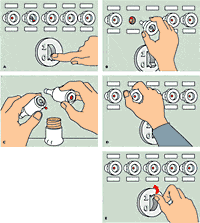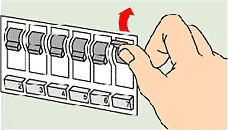Fuses and fault current guards
The safe functioning of all electric appliances is guarded by fuses and, in the newest buildings, also by fault current guards. The fuses react to overloading, which can arise from a short occurring in a faulty appliance: the fuse blows, breaking the circuit. The fault current guard is a device for switching the current off a faulty appliance so fast that the user is saved from any permanent injury to health by an electric shock.
The fuses and the fault current guard are usually located in the same fuse board in the entrance hall. Usually, the fault current guard has been installed to guard the plug socket sets or lighting sets of damp premises. Outdoor plug sockets and lighting fixtures are also similarly protected. The fault current guard may also be attached to an individual plug socket. Old flats do not usually have fault current guards. The functioning of the fault current guard must be tested regularly. After the testing, the fault current guard must be returned to the working position by turning its switch to position I.
There are two types of fuses: the traditional changeable plug fuses and the newer automatic fuses, which can be reengaged by snapping the blown switch into the connected position. The fault current guard, too, can be reengaged. Before you change or reengage a fuse or fault current guard, find out what caused its blowing. Dispose of the faulty appliance. If the fuse keeps blowing or the fault current guard keeps tripping, call maintenance for help. Do not, under any circumstances, replace the fuse with any other object. That would be truly dangerous to life.
Changing a plug fuse

- Check which fuse is blown. When a fuse blows, the signal pin at its end comes off.
- Switch off the current by turning the main switch to position 0. (Figure A)
- Remove the fuse holder, with the blown fuse, by turning it. (Figure B)
- Check the ampere rating of the blown fuse and replace it with a new one with the same rating. So if it’s 10A fuse, replace it with 10A fuse only. (Figure C)
- Put the fuse holder back with the new fuse and turn it tight. (Figure D)
- Switch on the current from the main switch. (Figure E)

All the lamps and fuses in the flat are supposed to be intact when you move in. If they’re not, give a notice of defects, and an Elli maintenance person will come and change them. From then on, you will be responsible for changing the lamps and fuses.


